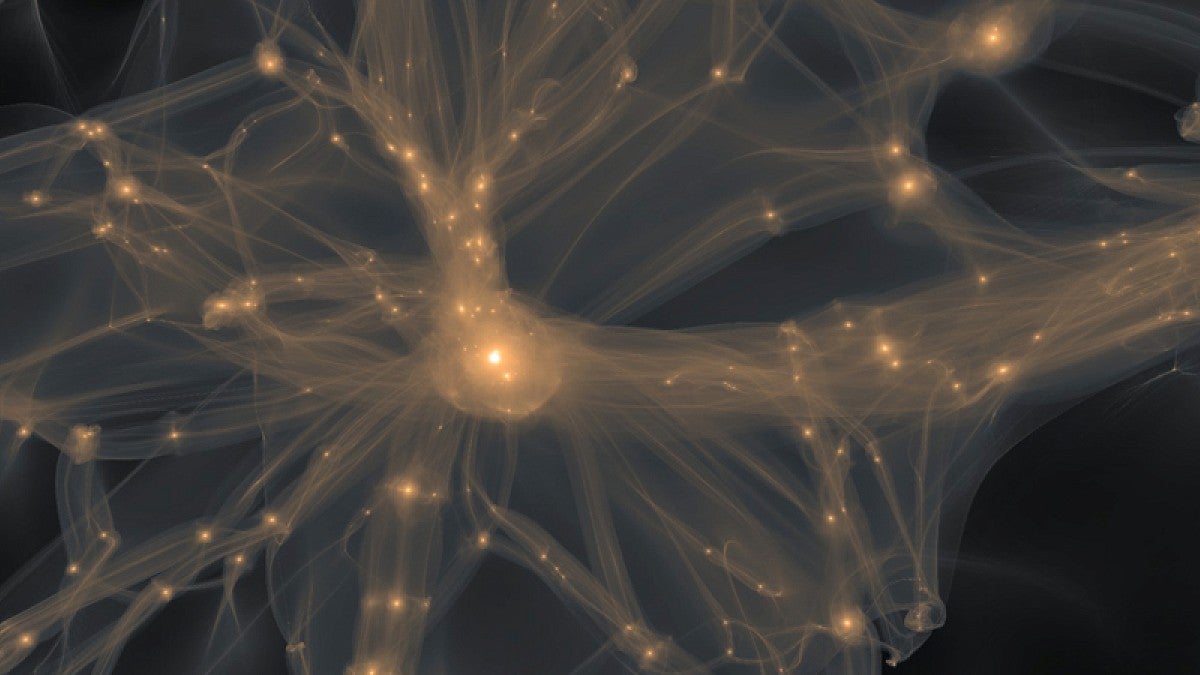Dark matter is out there, somewhere. Helping to find it is the task of theoretical work by UO physicists.
In May, the UO Institute of Theoretical Science hosted a symposium featuring researchers from across North America. They discussed where the science is now and where it may go, said Graham Kribs, a professor in the Department of Physics and a member of the institute.
"We know dark matter exists gravitationally," Kribs said. "Many pieces of independent evidence point to that. We know a great deal about what is not dark matter, but we don't quite know what it is."
Defining dark matter isn't easy. It is thought to be particles that can only feebly interact with the known particles of the universe. The particles, whatever they are, are tied to the expansion of the universe, beginning with the Big Bang.
Scientists have strong evidence from observations of the first light, when the universe became transparent to visible wavelengths of light. So far, however, the evidence has been revealed only through dark matter’s gravitational effects on galactic and larger scales.
Finding dark matter, Kribs said, is about advancing fundamental knowledge about the universe.
"We would not be here if it weren't for dark matter," said Tim Cohen, also a UO physics professor and member of the Institute of Theoretical Science. "The seeds for our galaxy were set by dark matter. Dark matter fell in first, and it was the gravitational effect of dark matter that brought the stuff we're made out of together to form galaxies and, ultimately, us."
Experimentalists in several disciplines are looking for dark matter.
Astrophysicists are using telescopes to scour galaxies of vast shape and size, searching for any signal not consistent with known astrophysics. Collider experimentalists have created particle collisions at various sites including the Large Hadron Collider in Europe, looking for the telltale signs of dark matter production as missing energy that occurs and quickly disappears after a collision. Others are using laboratory experiments deep underground, seeking individual dark matter particles collisions with a single atom’s nucleus or one of its electrons producing a detectable signal.
Experiments over two-plus decades, however, have not found dark matter, and instead have set tighter and tighter limits on dark matter’s interactions with normal matter, Kribs said. The symposium, “New Lampposts for Dark Matter," offered a chance for a new generation of physicists, such as those at the UO, to learn about existing barriers and bring new ideas to the search, he said.
The idea that dark matter exists, said Spencer Chang, also a physics professor and institute member, is seen in gravitational effects, such as those seen in rotating galaxies and gravitational lensing. The latter refers to how light from a distant massive object in space bends around another object, like a kaleidoscope, tricking a distant viewer to seemingly see multiple objects.
"A discovery could be imminent, or it could be scientists are looking in the wrong place," Cohen said. "Currently, we are searching for a finite list of maybe 10-ish possibilities for what dark matter is. It may be time to quit exposing our biases on where we think it might be and look for it anywhere we can."
Figuring out new approaches is up the alley of high-energy theorists.
"We have our own theories," Kribs said. "Some involve satisfying constraints from searches at experiments such as the Large Hadron Collider, which is not an easy task. It's 'imagination in a straitjacket,' as Richard Feynman once said.”
Theoretical physicists also often help experimentalists design new searches to test such ideas, he said.
It's possible, Cohen said, that dark matter has been detected, but data-analysis techniques at the Large Hadron Collider and Laser Interferometer Gravitational Wave Observatory, or LIGO, weren't able to identify the evidence. The UO team is working on new ways to study old and new data.
Plugging in math-heavy theoretical approaches, Chang said, could enhance existing experiments and drive new ones.
Recent research papers by Kribs and Chang have fed new ideas in the hunt for dark matter. They involve simple changes on how dark matter may scatter — at a much higher energy than predicted by previous theories of dark matter.
"Even though we don't understand dark matter's properties, we can still classify them into different categories that allow for certain restraints," Chang said. "For example, if we propose a simple modification to what a signal may look like, dark matter may appear at a much higher energy than expected."
The UO's efforts, supported primarily by the U.S. Department of Energy, will soon have a new face. Ben Farr, a postdoctoral scientist now at the University of Chicago with expertise on black hole mergers and LIGO-data analyses, will join the UO in the fall. Farr had a major role in LIGO's initial detection of a gravitational wave last September.
"Understanding dark matter's fundamental nature stands to have major implications on particle physics, cosmology and astrophysics," Chang said. "A lot of advances will come out of the technology that goes into the searches. Spinoffs always happen."
One possibility raised in a talk by symposium guest Rouven Essig, a physicist from Stony Brook University, could be cameras capable of reading larger quantities of pixels. That, Cohen said, would allow for "great low-light photos from our cellphones, and who doesn’t want to be able to take better selfies?"
—By Jim Barlow, University Communications


